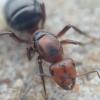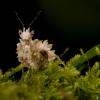In Hawaii, where P. gracilis is common, I found out how to raise them with very low mortality rates. I used no outworlds, just a flat-ended, plastic test tube. Here's how:
Step 1: Clean out a tube, with no water or cotton at all.
Step 2: Cut a piece from a clear drinking straw (one barely wide enough to accommodate a P. gracilis queen, they sure love small nests) that is about 1/3 the length of the tube.
Step 3: Insert it in.
Step 4: Press pieces of damp cotton around the straw, but keep the straw pressed up against the side of the tube (for visibility). Add cotton until the cotton reaches the tip of the straw.
Step 5: Add the queen and plug the tube. The queen should nest in the straw, with the open half of the tube serving as an outworld (in my experience, they prefer termites, pinhead crickets, raw honey, and the occasional queen gaster). Occasionally dampen the cotton a bit (not too much, this species likes it very dry)
Step 6: When the first workers eclose, put the entire tube in an outworld.




















